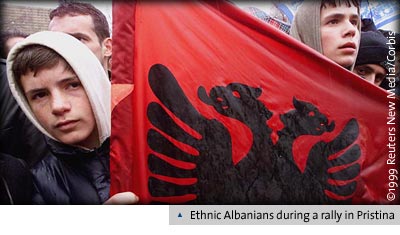






| 


On the one-year anniversary of NATO's 1999 war against Serbia--a war fought to
prevent Serbian President Slobodan Milosevic from deporting or destroying the
Albanian population of Kosovo--"War in Europe" offers the first in-depth
examination of what led to the war, how it was fought, and what it achieved.
"War in Europe" draws on hundreds of hours of news footage, home videos filmed by
the Kosovo Liberation Army, Kosovar refugees, and gun camera footage in NATO
archives, to chronicle NATO's first war in its 50-year history.
In Part One,"The Road to War," FRONTLINE sketches the roots of the
conflict: the Kosovar Albanians' fight for independence from Serb oppression,
why Milosevic and Serbia could never give up Kosovo, and how, despite intense
diplomatic efforts by the West, violence between the Kosovo Liberation Army and
Milosevic's brutal retaliation escalated throughout 1998.
This first chapter relates how Washington and NATO at first were not prepared to
fight the war. Secretary of State Madeleine
Albright, a champion of using force for moral reasons, tried to push
President Clinton toward military intervention in Kosovo. When Clinton
finally agreed, he publicly ruled out ground troops. The Clinton team calculated
that the threat of bombs alone would force Milosevic to withdraw from Kosovo.
But NATO lost its gamble. Serbia's leader stood firm and Serb troops
accelerated their ethnic cleansing on the ground.
In Part Two, "The Real War," FRONTLINE chronicles how NATO's war--launched March 24,1999--came by increments and was
fought by committee. Interviews with U.S. Defense Secretary William Cohen and
other policymakers reveal how the war's strategy and tactics
were hamstrung by political considerations in Washington and among
the other 18 NATO nations.
"No set of targets was more important than maintaining the consensus of NATO."
says General Wesley Clark, NATO Supreme Allied Commander. Clark, along with
General Charles Krulak and General Klaus Naumann, offer behind-the-scenes
accounts of the war and its political constraints. NATO pilots could fight only in Kosovo and couldn't strike at
strategic targets in Serbia. Without ground troops, it was a mission that would prove almost impossible.
As evidence mounted that the air war was failing to protect Kosovar Albanians on
the ground and that NATO possibly was losing the war, British Prime Minister Tony
Blair pushed for planning a ground force invasion. Around the same time, NATO's
bombers began pounding targets in downtown Belgrade--something Lt. Gen Michael
Short,head of NATO's air campaign, had argued for from the start. Finally,
with the intervention of Russia, a deal was struck with Milosevic and 78 days
after it started, the air war against Milosevic ended.
However, with hostilities remaining between the two warring sides, and with the
prospect that NATO troops will be in Kosovo for a long time to come, no one today is
claiming a great victory in this latest Balkan conflict.

home .
interviews .
how it was fought .
ethnic cleansing .
fighting for morals .
video .
discussion
facts & figures .
readings .
chronology .
links .
map
synopsis .
press .
tapes & transcripts .
FRONTLINE .
pbs
web site copyright WGBH educational foundation

|